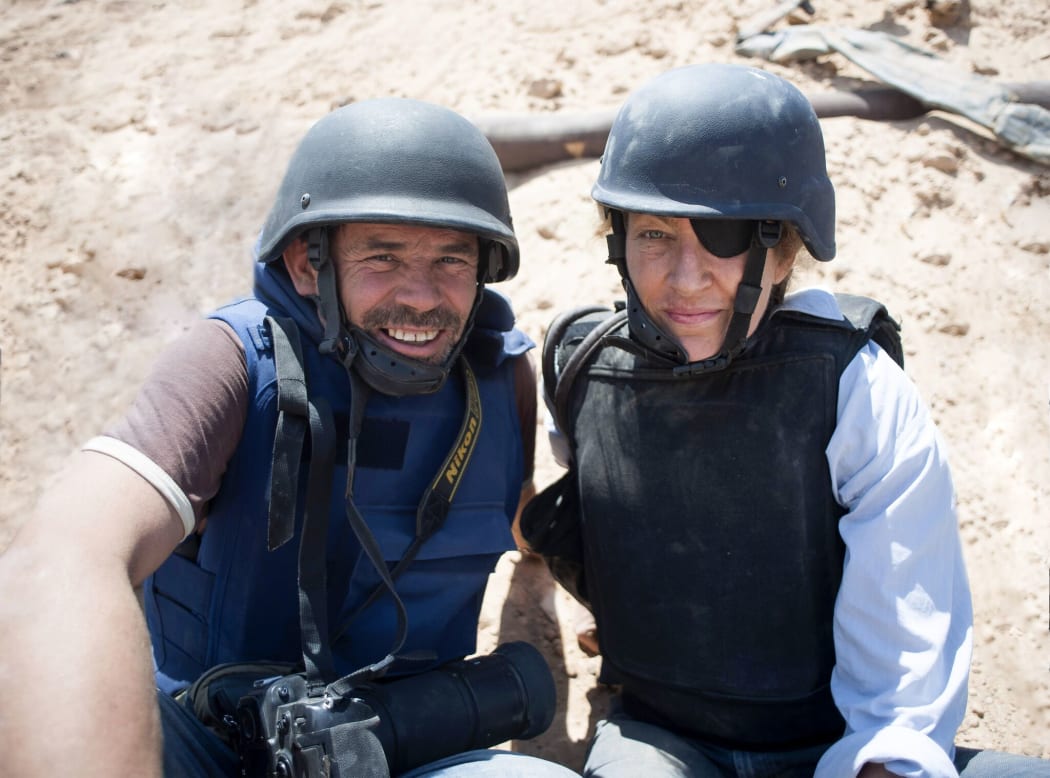Photographer Paul Conroy was with The Sunday Times' war correspondent Marie Colvin when the pair illegally crossed the border into Syria in February 2012. They were there to document the plight of civilians trapped in the besieged city of Homs, but it was to be Colvin's final assignment.
The compound they were in was attacked by Assad's forces in what was found by US courts to be a deliberate attack on journalists.

Paul Conroy and Marie Colvin in the field Photo: Sunday Times
In Under The Wire (Rialto Channel, Thursday 5th December) Conroy recounts what happened to him on the fateful mission and how he survived it. He also describes his friendship with Colvin, and a career spent working in some of the world's most dangerous trouble spots.
He tells Kim Hill he knew from the beginning that what happened to Colvin was no accident.
“I recognised the fire pattern – I was an ex-soldier – so I kind of knew the pattern to track on to the media centre… what they do is they fire empty artillery shells out of a rocket. They fired the first batch of them and it was two, they hit about 100 meters either side of the media centre. Then, 30 seconds later, they have a drone up which adjusted the pattern, so they moved them in by about 50 meters. I knew at that point, when I heard them come closer the way they were, that we were about to be hit.
“I knew I had about 30 seconds at that point to do something. People were yelling ‘get out’ and I was yelling ‘stay in’ because you actually have more of chance surviving the shrapnel if you’re behind a wall or on the floor inside the building.”
He says it took about five years of investigation by a team of lawyers in the US who got information from defectors that there were systems in place to deliberately track and kill journalists.
“Even before we went in, we were informed by Lebanese intelligence officers that they’d picked up Syrian radar traffic that said any journalists caught around Homs were to be executed and have their bodies thrown on the battlefield. So, we kind of knew we were going into a dangerous situation but we never realised it was quite as sophisticated and deliberate as it was.”
The judge ruled that Colvin had been specifically targeted for assassination because of her reporting.
Conroy was badly injured in the attack with shrapnel causing extensive damage to his leg. It was six days before he could get out of Syria.
“The Free Syrian Army threw me in a truck and took me to the field clinic that we’d been reporting from where Dr Mahomed patched up our wounds. We had to lay low because we were surrounded, it was a full on siege.”
After six days, with Syrian forces closing in with a ground operation the Free Syrian Army knew they had to get them out. Conroy and 23 others were driven through the frontlines and 13 of them died in the first 15 minutes of the escape.
“They really just wanted to get us out so we could continue to tell the story because this medieval siege was just destroying civilians. It was a slaughterhouse.”
Conroy was lowered into a tunnel about five meters below the ground. He was too injured to walk, so he had to use a motorbike.
“It was a last ditch attempt to get someone out to tell the story of what was happening to the civilians who were being butchered in Homs.”
While he hasn’t currently got plans to go back, he says he has no aversion to it and the incident didn’t put him off.
“At this point in time, I’ve made the decision that while I’m in a position to keep speaking out, I will.”

